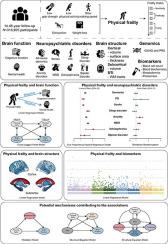遗传机制、脑结构和外周生物标志物介导了身体虚弱和神经精神疾病之间的关系
IF 13
1区 综合性期刊
Q1 MULTIDISCIPLINARY SCIENCES
引用次数: 0
摘要
以多系统功能下降为特征的身体虚弱已成为不良健康结果的重要危险因素。然而,身体虚弱、脑功能和神经精神疾病之间的关系及其潜在机制仍不清楚。目的全面探讨躯体虚弱与脑功能和神经精神疾病的关系,并探讨其可能的机制。方法在英国生物银行队列研究中,使用以下五个标准评估身体虚弱:疲惫,握力,体力活动,体重减轻和步行速度。我们使用回归和交叉滞后面板模型检验了心理健康和认知之间的横断面和纵向关联。Cox比例风险模型用于评估与神经精神疾病的纵向关联。我们使用孟德尔随机化(MR)来研究潜在的因果关系,而神经影像学分析则确定了与虚弱相关的大脑区域。采用中介分析和结构方程模型来探讨其潜在机制。结果在316,905名参与者中(中位随访时间:14.47 年),身体虚弱与心理健康恶化和认知能力下降存在显著的横断面和纵向关联。身体虚弱因各种原因引起的痴呆的风险(HR = 2.14),帕金森病(HR = 1.47),中风(HR = 1.69)、睡眠障碍(HR = 2.63),焦虑症(HR = 2.37),重度抑郁症(MDD;HR = 2.88),精神分裂症(HR = 3.76)。MR分析提示身体虚弱与重度抑郁症(OR = 1.25)和焦虑症(OR = 1.30)之间存在潜在的因果关系。此外,神经影像学分析强调了身体虚弱与额叶皮层以及皮层下区域(如丘脑、侧脑室和海马体)的变化之间的相关性。遗传、脑区域和外周生物标志物(总胆固醇、GDF15、WFDC2)在很大程度上介导了虚弱和神经精神疾病之间的关系。结论本研究为身体虚弱与脑功能障碍之间的联系提供了全面的证据,提示早期虚弱干预是预防脑功能障碍和神经精神障碍的潜在策略。本文章由计算机程序翻译,如有差异,请以英文原文为准。

Genetic mechanisms, brain structures, and peripheral biomarkers mediate the relation between physical frailty and neuropsychiatric disorders
Introduction
Physical frailty, which is characterized by multisystem functional decline, has emerged as a significant risk factor for adverse health outcomes. However, the relationship among physical frailty, brain function, and neuropsychiatric disorders, along with the underlying mechanisms, remains unclear.Objectives
To comprehensively investigate the association of physical frailty with brain function and neuropsychiatric disorders and explore the potential mechanism.Methods
In the UK Biobank cohort study, physical frailty was assessed using the following five criteria: exhaustion, grip strength, physical activity, weight loss, and walking speed. We examined cross-sectional and longitudinal associations between mental health and cognition using regression and cross-lagged panel models. Cox proportional hazards models were used to assess longitudinal associations with neuropsychiatric disorders. We used Mendelian randomization (MR) to investigated potential causal relationships, whereas neuroimaging analyses identified frailty-related brain regions. Mediation analyses and structural equation modelling were used to explored the underlying mechanisms.Results
Among 316,905 participants (median follow-up: 14.47 years), physical frailty showed significant cross-sectional and longitudinal associations with mental health deterioration and cognitive decline. Physical frailty increased the risks of all-cause dementia (HR = 2.14), Parkinson’s disease (HR = 1.47), stroke (HR = 1.69), sleep disorder (HR = 2.63), anxiety disorder (HR = 2.37), major depressive disorder (MDD; HR = 2.88), and schizophrenia (HR = 3.76). The MR analysis suggested potential causal relationships between physical frailty and MDD (OR = 1.25) and anxiety disorder (OR = 1.30). Moreover, neuroimaging analyses highlighted a correlation between physical frailty and changes in the frontal cortex, as well as subcortical regions such as the thalamus, lateral ventricle, and hippocampus. Genetics, brain regions, and peripheral biomarkers (total cholesterol, GDF15, WFDC2) substantially mediate the relationship between frailty and neuropsychiatric disorders.Conclusion
This study provides comprehensive evidence linking physical frailty to brain dysfunction, suggesting that early frailty intervention is a potential strategy for preventing brain dysfunction and neuropsychiatric disorder.求助全文
通过发布文献求助,成功后即可免费获取论文全文。
去求助
来源期刊

Journal of Advanced Research
Multidisciplinary-Multidisciplinary
CiteScore
21.60
自引率
0.90%
发文量
280
审稿时长
12 weeks
期刊介绍:
Journal of Advanced Research (J. Adv. Res.) is an applied/natural sciences, peer-reviewed journal that focuses on interdisciplinary research. The journal aims to contribute to applied research and knowledge worldwide through the publication of original and high-quality research articles in the fields of Medicine, Pharmaceutical Sciences, Dentistry, Physical Therapy, Veterinary Medicine, and Basic and Biological Sciences.
The following abstracting and indexing services cover the Journal of Advanced Research: PubMed/Medline, Essential Science Indicators, Web of Science, Scopus, PubMed Central, PubMed, Science Citation Index Expanded, Directory of Open Access Journals (DOAJ), and INSPEC.
 求助内容:
求助内容: 应助结果提醒方式:
应助结果提醒方式:


